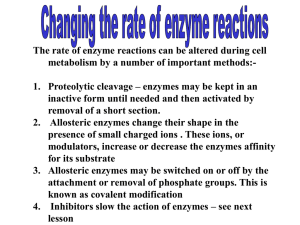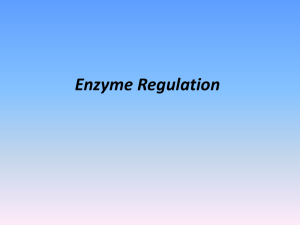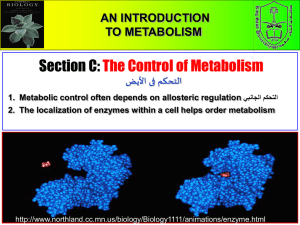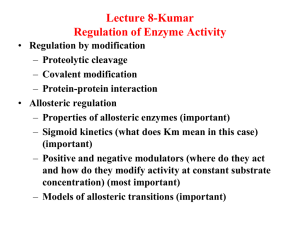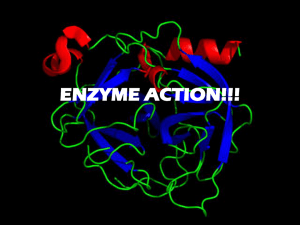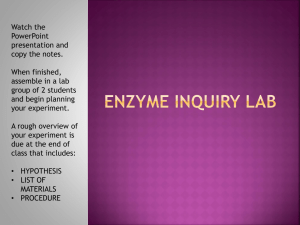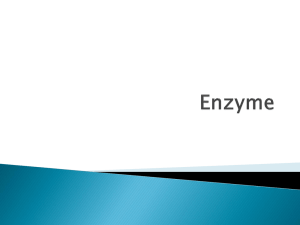15.1 – What Factors Influence Enzymatic Activity?
advertisement
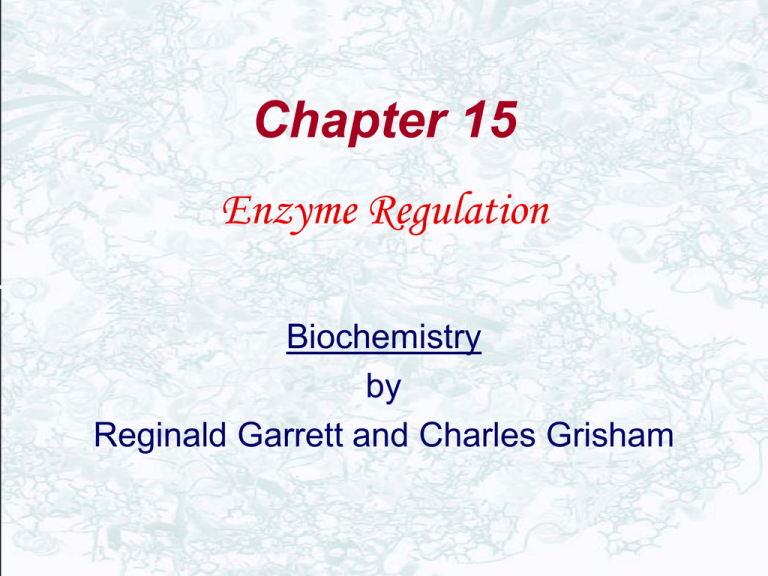
Chapter 15 Enzyme Regulation Biochemistry by Reginald Garrett and Charles Grisham Essential Question 1. What are the properties of regulatory enzymes? 2. How do regulatory enzymes sense the momentary needs of cells? 3. What molecular mechanisms are used to regulate enzyme activity? Outline of Chapter 15 1. What Factors Influence Enzymatic Activity? 2. What Are the General Features of Allosteric Regulation? 3. Can Allosteric Regulation Be Explained by Conformational Changes in Proteins? 4. What Kinds of Covalent Modification Regulate the Activity of Enzymes? 5. Is the Activity of Some Enzymes Controlled by Both Allosteric Regulation and Covalent Modification? 15.1 – What Factors Influence Enzymatic Activity? • The activity displayed by enzymes is affected by a variety of factors, some of which are essential to the harmony of metabolism • Two of the more obvious ways to regulate the amount of activity are 1. To increase or decrease the number of enzyme molecule (enzyme level) 2. To increase or decrease the activity of each enzyme molecule (enzyme activity) A general overview of factors influencing enzyme activity includes the following considerations 1. Rate depends on substrate availability 2. Rate slows as product accumulates 3. Genetic controls (transcription regulation) induction and repression (enzyme level) 4. Enzyme activity can be regulated allosterically 5. Enzyme activity can be regulated through covalent modification 6. Zymogens, isozymes and modulator proteins may play a role Figure 15.1 Enzyme regulation by reversible covalent modification. Zymogens Figure 15.2 Proinsulin is an 86residue precursor to insulin (the sequence shown here is human proinsulin). Proteolytic removal of residues 31 to 65 yields insulin. Residues 1 through 30 (the B chain) remain linked to residues 66 through 87 (the A chain) by a pair of interchain disulfide bridges. Serine protease: Kallikrein VIIa IXa Xa XIa XIIa Thronbin Figure 15.4 The cascade of activation steps leading to blood clotting. Rich in negative charge formation of a blood clot. Isozymes 1. LDH M is a A4 homotetramer in muscle 2. LDH H is a B4 homotetramer In heart 3. Different tissues express different isozyme forms, as appropriate to particular metabolic needs Figure 18.21 (b) In oxygendepleted muscle, NAD+ is regenerated in the lactate dehydrogenase reaction. 1. LDH M works best in pyruvate-to-lactate direction. 2. LDH H works best in lactate-to-pyruvate direction • Modulator proteins are another way that cells mediate metabolic activity – cAMP-dependent protein kinase – Phosphoprotein phosphatase inhibitor-I 15.2 – What Are the General Features of Allosteric Regulation? Action at "another site" • Allosteric regulation acts to modulate enzymes situated at key steps in metabolic pathways Enz 1 Enz 2 Enz 3 Enz 4 Enz 5 A B C D E F • F, the essential end product, inhibits enzyme 1, the first step in the pathway • This phenomenon is called feedback inhibition or feedback regulation • Regulatory enzymes have certain exceptional properties 1. Their kinetics do not obey the Michaelis-Menten equation – Their v versus [S] plots yield sigmoid- or Sshaped curve – A second-order (or higher) relationship between v and [S] – Substrate binding is cooperative • Regulatory enzymes have certain exceptional properties 1. Their kinetics do not obey the Michaelis-Menten equation 2. Inhibition of a regulatory enzyme by a feedback inhibitor does not conform to any normal inhibition pattern - Feedback inhibitor (Product) bears the structural similarity to A, may bind to substrate-binding site - If product acts at a site other than the substrate-binding site—called Allosteric inhibition • Regulatory enzymes have certain exceptional properties 1. Their kinetics do not obey the Michaelis-Menten equation 2. Inhibition of a regulatory enzyme by a feedback inhibitor does not conform to any normal inhibition pattern- Allosteric inhibition 3. Some effector molecules exert negative effects on enzyme activity, other effectors show stimulatory, or positive, influences on activity 4. Oligomeric organization 5. The regulatory effects exerted on the enzyme’s activity are achieved by comformational changes occurring in the protein when effector metabolites bind 15.3 – Can Allosteric Regulation Be Explained by Conformational Changes in Proteins? Symmetry model : Two conformational states • Monod, Wyman, Changeux (MWC) Model: allosteric proteins can exist in two states: R (relaxed) and T (taut) • In this model, all the subunits of an oligomer must be in the same state (R or T) • T state predominates in the absence of substrate S R1 R0 T0 T1 L= T0 / R0 L is equilibrium constant • Although the relative [R0] concentration is small, S will bind ‘only’ to R0, forming R1 – S binds much tighter to R than to T • S-binding drives the conformation transition, T0 R0 (because R0 becomes R1 , R0 decreases) • Cooperativity is achieved because S binding increases the population of R, which increases the sites available to S • K0.5 (Km) • Ligands such as S are positive homotropic effectors • Molecules that influence the binding of something other than themselves are heterotropic effectors – Positive heterotropic effectors or allosteric avtivators (T0 R0) – negative heterotropic effectors or allosteric inhibitors (R0 T0) The sequential model • Proposed by Koshland, Nemethy, and Filmer (the KNF model) relies on the idea that ligand binding triggers a conformation change in a protein • If the protein is oligomeric, ligand-induced conformation changes in one subunit may lead to conformation changes in adjacent subunits The notable difference between the MWC and KNF model 1. In the MWC model, the different conformations have different affinities for the various ligand 2. the KNF model is based on ligand-induced conformation changes Figure 15.8 The KoshlandNemethy-Filmer sequential model for allosteric behavior. 15.4 What Kinds of Covalent Modification Regulate the Activity of Enzymes? Covalent modification through reversible phosphorylation • This is the most prominent form of covalent modification in cellular regulation 1. Phosphorylation is accomplished by protein kinases—each protein kinase targets specific proteins for phosphorylation 2. Phosphoprotein phosphatases catalyze the reverse reaction – removing phosphoryl groups from proteins • Protein kinases and phosphatases work in opposing directions Figure 15.1 Enzyme regulation by reversible covalent modification. • Protein kinases phosphorylate Ser, Thr, and Tyr residues in target proteins (Table 15.2) • Phosphorylation introduces a bulky group bearing two negative charges, causing conformational changes that alter the target protein’s function • Protein kinases are classified as Ser/Thr and/or Tyr specific • Kinases are often regulated by intrasteric control Phosphorylation is Not the Only Form of Covalent Modification that Regulates Protein Function • Several hundred different chemical modifications of proteins have been discovered • Only a few of these are used to achieve metabolic regulation through reversible conversion of an enzyme between active and inactive forms • A few are summarized in Table 15.3 • Three of the modifications in Table 15.3 require nucleoside triphosphates (ATP, UTP) that are related to cellular energy status 15.5 Is the Activity of Some Enzymes Controlled by Both Allosteric Regulation and Covalent Modification? Glycogen phosphorylase cleaves glucose units from nonreducing ends of glycogen • A phosphorolysis reaction (Fig 15.12) • Regulated both by allosteric control and by covalent modification • Glucose-1-P is converted to glucose-6-P • In muscle, proceeds into glycolysis (chapter 18) • In liver, hydrolysis of glucose-6-P yields glucose Figure 15.12 The glycogen phosphorylase reaction. Figure 15.13 The phosphoglucomutase reaction. • Muscle glycogen phosphorylase is a dimer of two identical subunits (842 residues) – Each subunit contains a pyridoxal phosphate (PLP) cofactor covalently linked (Lys-680) – A tower helix (residues 262 to 278) – An allosteric effector site near the subunit interface – A regulatory phosphorylation site (Ser14) – A glycogen binding site – An active site Glycogen Phosphorylase Activity is Regulated Allosterically • Cooperativity in substrate binding (15.15a) – Inorganic phosphate (Pi) is a positive homotropic effector • ATP and Glucose-6-P are feedback inhibitors, and negative heterotropic effectors (i.e., allosteric inhibitor) (15.15b) • AMP is a positive heterotrophic effector (i.e., allosteric activator) (15.15c) • ATP and AMP bind to the same site (reciprocal regulation in the cellular concentration of ATP and AMP Figure 15.14 v versus S curves for glycogen phosphorylase. The response to the concentration of the substrate phosphate (Pi). ATP is a feedback inhibitor. AMP is a positive effector. It binds at the same site as ATP. MWC model • The active form of the enzyme is designated the R state • The inactive form of the enzyme is denoted as the T state • AMP promotes the conversion to the active state • ATP, glucose-6-P, and caffeine favor conversion to the inactive T state • A significant change occurs at the subunit interface between the T (Asp283) and R state (Arg569) –Pi • This conformational change at the subunit interface is linked to a structural change at the active site that affects catalysis (fig 15.17) Figure 15.16 The mechanism of covalent modification and allosteric regulation of glycogen phosphorylase. The T states are blue and the R states blue-green. Regulation of GP by Covalent Modification • In 1956, Edwin Krebs and Edmond Fischer showed that a ‘converting enzyme’ could convert phosphorylase b to phosphorylase a • Three years later, Krebs and Fischer show that this conversion involves covalent phosphorylation (Figure 15.16) • Phosphorylation of Ser14 causes a dramatic conformation change in phosphorylase (Figure 15.17) Figure 15.17 The major conformational change that occurs in the N-terminal residues upon phosphorylation of Ser14. Ser14 is shown in red. N-terminal conformation of phosphorylated enzyme (phosphorylase a): yellow. N-terminal conformation of unphosphorylated enzyme (phosphorylase b): cyan. This phosphorylation is mediated by an enzyme cascade • Cyclic AMP (cAMP) is the intracellular agent of extracellular hormones - thus a ‘second messenger’ • Hormone binding stimulates a GTP-binding protein (G protein), releasing G(GTP) • Binding of G(GTP) stimulates adenylyl cyclase to make cAMP Figure 15.18 The hormone-activated enzymatic cascade that leads to activation of glycogen phosphorylase. Figure 15.19 The adenylyl cyclase reaction yields 3',5' -cyclic AMP and pyrophosphate. The reaction is driven forward by subsequent hydrolysis of pyrophosphate by the enzyme inorganic pyrophosphatase. Figure 15.20 Hormone binding to its receptor leads via G-protein activation to cAMP synthesis. Adenylyl cyclase and the hormone receptor are integral membrane proteins; Gα and Gβγ are membrane-anchored proteins. Hemoglobin • • • • • A classic example of allostery Hemoglobin (Hb) and myoglobin (Mb) are oxygen transport and storage proteins Compare the oxygen binding curves for hemoglobin and myoglobin Myoglobin is monomeric; hemoglobin is tetrameric Mb: 153 residues Hb: two s of 141 residues, 2 bs of 146 (2b2) Hemoglobin Function Hb must bind oxygen in lungs and release it in capillaries • Adjacent subunits' affinity for oxygen increases • This is called positive cooperativity Figure 15.21 O2-binding curves for hemoglobin and myoglobin. The Bohr Effect • • • • Competition between oxygen and H+ Discovered by Christian Bohr Binding of protons diminishes oxygen binding Binding of oxygen diminishes proton binding Important physiological significance Figure 15.33 The oxygen saturation curves for myoglobin and for hemoglobin at five different pH values: 7.6, 7.4, 7.2, 7.0, and 6.8. Bohr Effect II Carbon dioxide diminishes oxygen binding • Hydration of CO2 in tissues and extremities leads to proton production • These protons are taken up by Hb as oxygen dissociates • The reverse occurs in the lungs The ionic binding of BPG to the two βsubunits of Hb. BPG lies at the center of the cavity between the two β-subunits. • Fetal Hb differs from adult Hb – with γ-chains in place of βchains – and thus a α2γ2 structure • Fetal Hemoglobin Has a Higher Affinity for O2 Because it has a Lower Affinity for BPG
